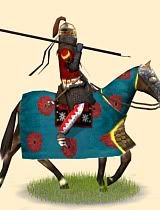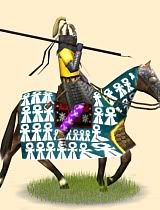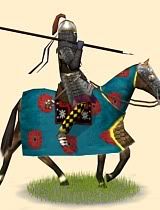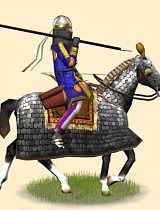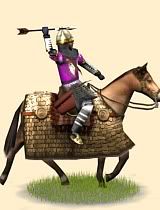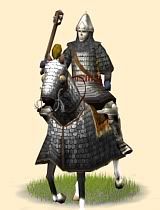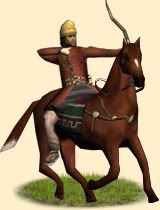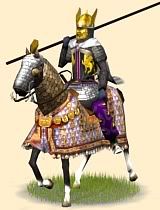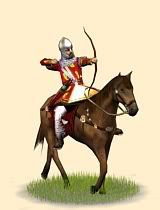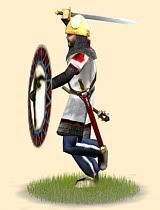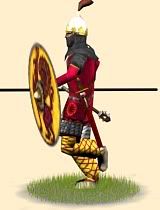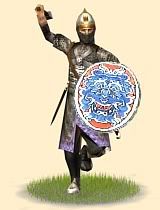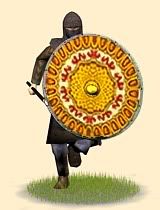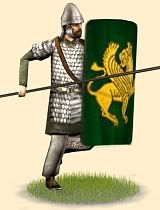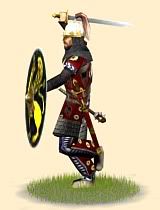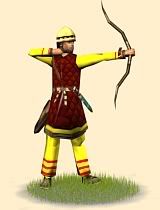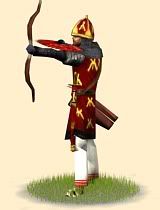Overview
The Sassanids were the last native dynasty to rule in Persia after the Parthians were overthrown and before the Arab conquest of later centuries. Sitting astride the trade routes to the east, the Sassanid court was fabulously opulent, and the empire was dynamic and efficiently run. The military was equally efficient and dangerous, and a constant challenge to the Eastern Roman Empire. What caused much of the tension with the Romans was the establishment of Zoroastrianism as the state religion in Sassanid lands and the subsequent persecution of Christians. This gave the Romans a pretext for war whenever it was needed. The Sassanids were certainly organised enough to expand their control of Armenia and to hold off the various steppe peoples. Rather than move southwards into Sassanid lands, most of these chose to head west towards the richer and far easier pickings of Rome.
A strong Sassanid leader has the chance to expand westwards while both halves of the Roman Empire are distracted by their own squabbles and barbarian hordes.
Historically the Sassanids lasted over 400 years from the fall of the Parthians until the coming of Islam and the Arabs. Islam replaced Zoroastrianism and the Caliphate made Persia a part of a new society.
Shapur II the Great
Shapur II was the ninth King of the Persian Sassanid Empire from 309 to 379. During his long reign, the Sassanid Empire saw its first golden era since the reign of Shapur I (241–272).
When King Hormizd II (302–309) died, Persian nobles killed his eldest son, blinded the second, and imprisoned the third (Hormizd, who afterwards escaped to the Roman Empire). The throne was reserved for the unborn child of one of the wives of Hormizd II. It is said that Shapur II may have been the only king in history to be crowned in utero: the crown was placed upon his mother's belly. This child, named Shapur, was therefore born king; the government was conducted by his mother and the magnates. But when Shapur II came of age, he turned out to be one of the greatest monarchs of the dynasty.
During the early years of the reign of Shapur, Arabs crossed the Persian Gulf from Bahrain to "Ardashir-Khora" of Pars and raided the interior. In retaliation, Shapur led an expedition through Bahrain, defeated the combined forces of the Arab tribes of "Taghlib", "Bakr bin Wael", and "Abd Al-Qays" and advanced temporarily into Yamama in central Najd. He resettled these tribes in Kerman and Hormizd-Ardashir. Arabs named him, as "Shabur Dhul-aktāf" or "Zol 'Aktāf" that means "The owner of the shoulders" after this battle.
In 337, just before the death of Constantine I (324–337), Shapur II broke the peace concluded in 297 between Narseh (293–302) and Emperor Diocletian (284–305), which had been observed for forty years. A twenty-six year conflict (337–363) began in two series of wars, the first from 337 to 350. After crushing a rebellion in the south, he headed toward Mesopotamia and recaptured Armenia. From there he started his first campaign against Constantius II, a campaign which was mostly unsuccessful for Shapur II. He was unable to take the fortress of Singara in the Siege of Singara (344). Shapur II also attempted with limited success to conquer the great fortresses of Roman Mesopotamia, Nisibis (which he besieged three times in vain) and Amida.
Although often victorious in battles, Shapur II made scarcely any progress. At the same time he was attacked in the east by nomad tribes, among whom the Xionites are named. He had to interrupt the war with the Romans and pay attention to the east. After a prolonged struggle (353–358) they were forced to conclude a peace, and their king, Grumbates, agreed to accompany Shapur II in the war against the Romans.
In 358 Shapur II was ready for his second series of wars against Rome, which met with much more success. In 359, Shapur II conquered Amida after a siege of seventy-three days, and he took Singara and some other fortresses in the next year (360). In 363 the Emperor Julian (361–363), at the head of a strong army, advanced to Shapur's capital at Ctesiphon and defeated a superior Sassanid army in the Battle of Ctesiphon, but was killed during his retreat. His successor Jovian (363–364) made an ignominious peace, by which the districts beyond the Tigris which had been acquired in 298 were given to the Persians along with Nisibis and Singara, and the Romans promised to interfere no more in Armenia. The great success is represented in the rock-sculptures near the town Bishapur in Persis (Stolze, Persepolis, p. 141); under the hoofs of the king's horse lies the body of an enemy, probably Julian, and a supplicant Roman, the Emperor Jovian, asks for peace.
Shapur II then invaded Armenia, where he took King Arshak II, the faithful ally of the Romans, prisoner by treachery and forced him to commit suicide. He then attempted to introduce Zoroastrian orthodoxy into Armenia. However, the Armenian nobles resisted him successfully, secretly supported by the Romans, who sent King Pap, the son of Arshak II, into Armenia. The war with Rome threatened to break out again, but Valens sacrificed Pap, arranging for his assassination in Tarsus, where he had taken refuge (374). Shapur II subdued the Kushans and took control of the entire area now known as Afghanistan and Pakistan. Shapur II had conducted great hosts of captives from the Roman territory into his dominions, most of whom were settled in Susiana. Here he rebuilt Susa, after having killed the city's rebellious inhabitants.
By his death in 379 the Persian Empire was stronger than ever before, considerably larger than when he came to the throne, the eastern enemies were pacified and Persia had gained control over Armenia.
Under Shapur II's reign the collection of the Avesta was completed, heresy and apostasy punished, and the Christians persecuted (see Abdecalas, Acepsimas of Hnaita). This was a reaction against the Christianization of the Roman Empire by Constantine I. He was successful in the east, and the great town Nishapur in Khorasan (eastern Parthia) was founded by him. He founded some other towns as well.
Video by Pseudo Romanus
Sassanid army
The birth of the Sassanid army (Persian: ارتش ساسانيان Artesh-e Sāsānīyān, Pahlavi Spâh سپاه, "army") dates back to the rise of Ardashir I (r. 226–241), the founder of the Sassanid dynasty, to the throne. Ardashir aimed at the revival of the Persian Empire, and to further this aim, he reformed the military by forming a standing army which was under his personal command and whose officers were separate from satraps, local princes and nobility. He restored the Achaemenid military organizations, retained the Parthian cavalry model, and employed new types of armour and siege warfare techniques. This was the beginning for a military system which served him and his successors for over 400 years, during which the Sassanid Empire was, along with the Roman Empire and later the East Roman Empire, one of the two superpowers of Late Antiquity in Western Eurasia. The Sassanid army protected Eranshahr ("the realm of Iran") from the East against the incursions of central Asiatic nomads like the Hephthalites, Turks, while in the west it was engaged in a recurrent struggle against the Roman Empire.
In the character of their warfare, the Persians of the Sassanid period differed greatly from their forebears under the Achaemenid kings. The principal changes which time had brought about were an almost entire disuse of the war chariot, the advance of the elephant corps into a very prominent and important position, and the increased use and pre-eminence of cavalry on the Parthian model, including both heavy cataphracts and horse-archers. Four main arms of the service were recognized, each standing on a different level: the elephants, the horse, the archers, and the ordinary footmen.
Divisions
In Pahlavi language, smaller divisions of the spāh were referred to as vasht and larger divisions were designated as gond. Interestingly, the Arabic word jond (Arabic: جند), meaning "army", is derived from the latter.
Ranks
Cavalry
- Erān Spahbod: Commander-in chief.
- Spahbod: Field general.
- Pādgospān or Padouspān (Modern Persian: پادوسبان): Commander of each of the four provincial divisions devised during the reign of Khosrau I.
- Marzbān or Kanārang: Equivalent to Margrave or commander of the border guards; according to Procopius, it had been equivalent in rank to the East Roman strategos or magister militum.
- Poshtikbān Sālār: Head of the royal guard.
- Erān anbāraghbad: Senior rank responsible for army supplies.
- Stor Bezashk: Senior vet who looked after the cavalry elite's mounts.
- Argbadh: Castellan, commander of a castle or fort.
- Pāyygān Sālār: Chief of an infantry division.
- Savārān Sardār: Head of a cavalry division.
- Gond Sālār: Commander of a gond division.
The backbone of the Spâh in the Sassanid era was its heavy armoured cavalry, known since Classical antiquity in the west as: Cataphracts. This was made up of noblemen who underwent extensive exercises in warfare and military manoeuvres through military training, gaining discipline and becoming truly elite soldiers. Within the Sassanid military, the cavalry was the most influential element, and Sassanid cavalry tactics were adopted by the Romans, Arabs, and Turks. Their weaponry, battle tactics, tamgas, medallions, court customs, and costumes greatly influenced their Romano-Byzantine neighbours.
The Romans had long contended against opponents who fielded heavy cavalry, notably the Sarmatians and the Parthians, and the recurrent wars with the Sassanids were an important factor in the Roman turn to new military organizations and battlefield tactics that centered around the use of heavy cavalry in the 3rd and 4th centuries. The Romans called these newly formed units clibanarii; It is said that the word clibanarii is derived from Persian word grivpanvar or griva-pana-vara meaning neck-guard wearer. Another, more direct and often quoted, etymology is the Greek word ho klibanos, which refers to a covered pot in which bread was baked or a small oven; perhaps a joking reference to the one-piece mask helmets they wore. The Roman term appears for the first time in the vita Alexandri Severi (56.5) in the Historia Augusta, a work from the very end of the 4th century A.D.
Shapur II (r. 309-379) further reformed the army by adopting heavier and more effective cavalry. These mounted units were clad in thick iron plates which covered their entire body. This made them look very much like moving iron statues. Some were armed with a lance and some with a sword and/or mace.
The fighting equipment of the heavily-armed Sassanid horsemen were:
The heavy cavalry was complemented by lighter cavalry, which were not made up of Sassanids, but were recruited from among their allies and supplemented by mercenary troops. Gelani (Guilani), Albani, Hephthalites, Kushans and the Khazars were the main suppliers of this light- to medium-armoured cavalry. They were an essential part of the Spâh because of their endurance and speed on the battlefield.
- Clibanarii cavalry: helmet, hauberk (Pahlavi griwban), breastplate, mail, gauntlet (Pahlavi abdast), girdle, thigh-guards (Pahlavi ran-ban) sword, mace, bowcase with two bows and two bowstrings, quiver with 30 arrows, two extra bowstrings, and horse armour (zen-abzar).
- Cataphract cavalry: helmet, hauberk, breastplate, mail, gauntlet, girdle, thigh-guards, bowcase with two bows and two bowstrings, quiver with 30 arrows, spear, and horse armour (zen-abzar); to these some have added a lasso (kamand), or a sling with pellets.
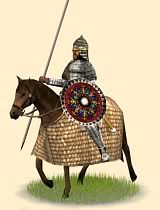

Armenian troops also served within the army: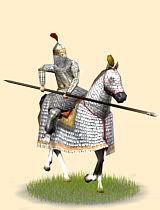
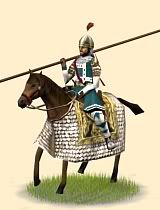
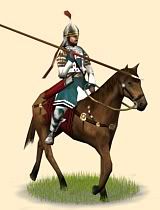
In short, there were the following classes of mobile cavalry troops:
Azadan nobility
- Pushtîghbân Grivpânvâr (Elite of the Elite):
- Zhâyedân Grivpânvâr (“Immortals” in Pahlavi):
- Jân-Âvspar (Religious Nobles):
- Azadan nobility Savaran: elite cavalry also described as the Persian knightly caste :
- War elephants (see below)
- Light cavalry: primarily horse-archers
- Medium cavalry: Medium-armoured cavalry armed with lance and shield
- Clibanarii cavalry: Heavy shock cavalry armed with maces and swords
- Cataphract cavalry: Heavy cavalry armed with lances (also known as Savārān cavalry )
This class of nobility was first formed in Parthian times, and was carried over into the Sassanid state, where they were a force to be reckoned with. They accompanied the king in the wars and displayed great courage and discipline. They are clearly the forerunners and founders of the "Knights" of later Arab history. The Aztan (Azadan, آزادان, "freemen") jealously guarded their status as descendants of the ancient Aryan conquerors and rulers of the mass of originally non-Aryan peasantry. These Azatan formed a numerous minor aristocracy of lower-ranking administrators, mostly living on their small estates and providing the cavalry backbone of Sassanid army. Most prestigious among them were the armoured "Aswaran" اسوران who normally decided the outcome of a battle.
Despite their downfall in the 7th century AD, the legacy of the Savaran endured in Europe, the Caucasus, India and the Muslim world. It was the elite cavalry of Sassanid Persia, who were the forerunners of the later Arabian Faris, the English knights, the Caucasian horsemen, the Indian Suwar (derived from Persian Savar), and the Turkish Tarkhans.
In point of fact, certain of the later Muslim heavy cavalry, such as the Mamluks, were possibly the descendants of the clibanarii cavalry, as they used similar weapons and tactics.
The amount of money involved in maintaining a warrior of the Asawaran (Azatan) knightly caste required a small estate, and the Asawaran knightly caste received that from the throne, and in return, were the throne's most notable defenders in time of war.
War elephants
Both types of cavalry units were supported by war elephants and elite foot archers who showered the enemy with storms of arrows. The elephant corps held the first position. It was recruited from India, but was at no time very numerous. Great store was set by it; and in some of the earlier battles against the Arabs the victory was regarded as gained mainly by this arm of the service. It acted with best effect in an open and level district; but the value put upon it was such that, however rough, mountainous, and woody the country into which the Persian arms penetrated, the elephant always accompanied the march of the Persian troops, and care was taken to make roads by which it could travel. The elephant corps was under a special chief, known as the Zend−hapet, or "Commander of the Indians," either because the beasts came from that country, or because they were managed by natives of Hindusta. These giant beasts acted as walking towers on battlefields and caused panic and disorder in enemy ranks, creating openings in the lines that cavalry could take advantage of.
Infantry
The infantry were mostly lightly-armoured spearmen, who, like their Achaemenid ancestors, were usually levied troops of little fighting ability. Procopius of Caesarea famously derided them as "a crowd of pitiable peasants who come into battle for no other purpose than to dig through walls and to despoil the slain and in general to serve the soldiers [i.e. the cavalrymen]. In some battles however, heavy infantry was deployed. These were well-paid, heavily-armoured infantry (carrying either sword or mace). The Daylam and Sogdiana provinces of the empire in particular were famous for providing high-quality foot soldiers.
The archers formed the elite of the Persian infantry. They were trained to deliver their arrows with extreme rapidity, and with an aim that was almost unerring. The huge wattled shields, adopted by the Achaemenid Persians from the Assyrians (called spara by the Achaemenids), still remained in use; and from behind a row of these, rested upon the ground and forming a sort of loop−holed wall, the Sassanid bowmen shot their weapons with great effect; nor was it until their store of arrows was exhausted that the Romans, ordinarily, felt themselves upon even terms with their enemy. Sometimes the archers, instead of thus fighting in line, were intermixed with the heavy horse, with which it was not difficult for them to keep pace. They galled the foe with their constant discharges from between the ranks of the horsemen, remaining themselves in comparative security, as the legions rarely ventured to charge the Persian mailed cavalry. If they were forced to retreat, they still shot backwards as they fled; and it was a proverbial saying with the Romans that they were then especially formidable. Infantry was divided into the following types:
Siege weapons
- Arteshtâr-î Daylamîg (heavy infantry):
- Tabargân-î Daylamîg (Elite Infantry):
- Arteshtâr-î Khwârâsân (Sughdian Warriors) :
- Arteshtâr-î Gęlânîg (Ghilanis):
- Paighân-î Sassâni: (medium infantry armed with spears and large shields):
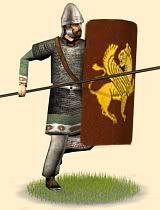
- JangAvaran-i Sassani (Heavy Infantry armed with javelins and swords):
- Payâhdag-î Nîzagân (Levy Spearmen armed with shield and spear):
- Kamândâr-î Payâhdag (Foot Archers):
- Kamândâr-î Shahi (Elite Foot Archers):
- Light ranged troops, such as Kurdish javelin-throwers, and slingers:
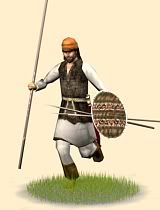
The Sassanids (unlike the Parthians) had organized and efficient methods of siege warfare for conquering walled towns. Many methods were learned from the Romans, but soon the Sassanids came to match them not only in the use of offensive siege engines such as scorpions, ballistae, battering rams, but also in the use of excellent defensive tactics for their fortifications, such as methods for using and countering catapults, for throwing stones or pouring boiling liquid on the attackers or by hurling fire brands and blazing missiles. Tabari reports that the main reason behind the victory of Vahriz over the Axumite army in Yemen has been the use of panjigan (probably a ballista equipped with heavy darts) against the Axumite forces who had not encountered such a military contraption in the past. [8]
- Scorpion (Pahlavi panjigān or çarx : a ballista equipped with heavy darts)
- Ballista
- Battering ram
- Onager (siege weapon) (Pahlavi koshkanjir or mangenik derived from Greek mēkhanikos)











